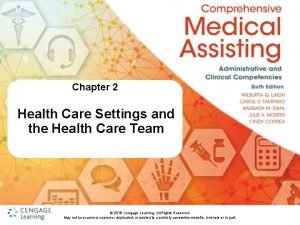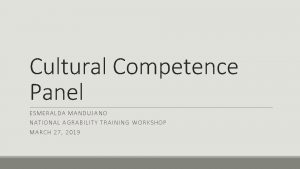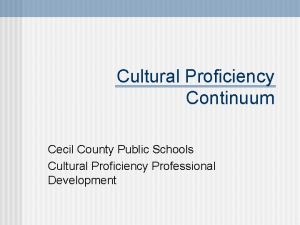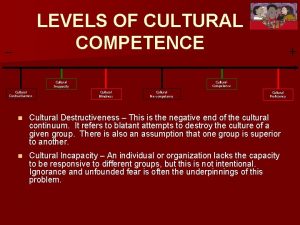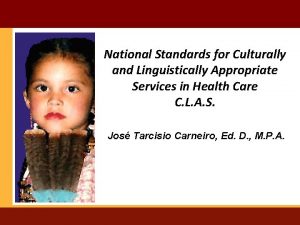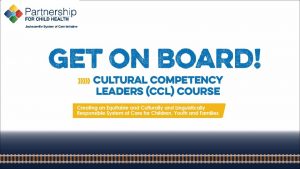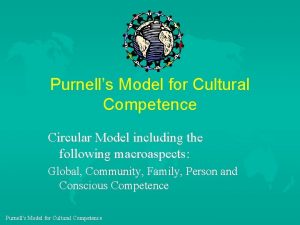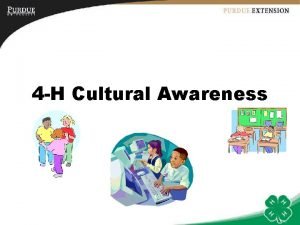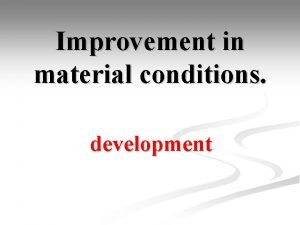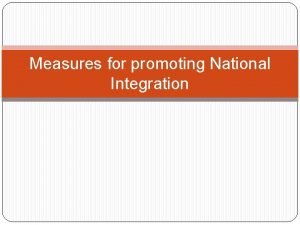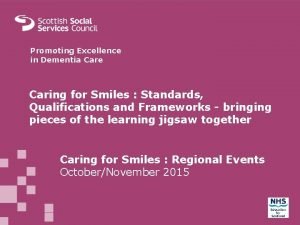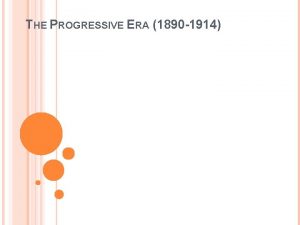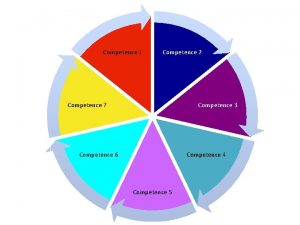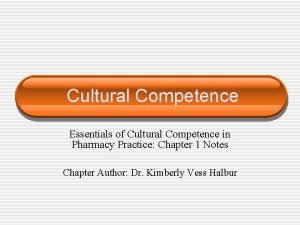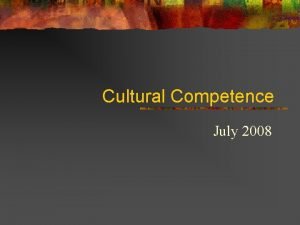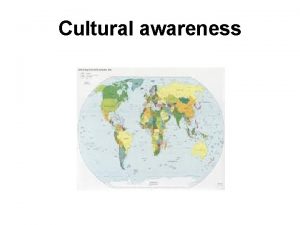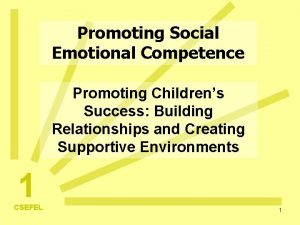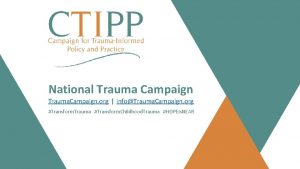Healthcare Equity Campaign raising awareness promoting cultural competence

































- Slides: 33

Healthcare Equity Campaign: raising awareness, promoting cultural competence, and the quest for sustainability within a healthcare system Megan Brady, MPH, MSW Senior Project Coordinator Institute on Multicultural Health Henry Ford Health System

Background § Henry Ford Health System is a Michigan not-for-profit corporation governed by community leaders. HFHS is one of the nation’s leading comprehensive, integrated health systems and is committed to improving the health and well-being of a diverse community. § Size – – 5 hospitals 29 medical centers 24, 000+ employees 3. 1 million patient contacts annually

Race by Zip Code GENESEE Bancroft Morrice SHIAWASSEE Oxford Ortonville Oxford Linden Byron Holly Clarkston Fowlerville LIVINGSTON Highland Hartland White Lake Waterford Highland Waterford Milford New Hudson Brighton ckbridge Gregory Pinckney Lakeland Hamburg South Lyon Plymouth Dexter Ann Arbor Chelsea WASHTENAW ass Lake Ann Arbor Canton Ann Arbor Ypsilanti Pontiac Southgate Belleville Wyandotte Saline New Boston Norvell Milan Trenton Grosse Ile Willis Flat Rockwood Onsted Source: LENAWEE Thomson Reuters Market Expert Database Macomb Algonac Harsens Island HFKH MONROE Maybee Carleton HFH Allen Park Detroit Lincoln Park Taylor Belleville South Rockwood HFWH Marine City New Baltimore Utica Fair Haven Macomb Detroit Detroit Gr Pt Redford. Detroit Livonia Detroit Gr Pt Detroit Redford Detroit Livonia Detroit Dearborn Heights Westland Detroit Garden City Dearborn Detroit Dearborn Westland Inkster Dearborn Melvindale Wayne Dearborn Heights Detroit Ann Arbor Manchester MACOMBNew Baltimore Utica Rochester WAYNE Ypsilanti East China New Haven Washington Romulus Bridgewater Casco Livonia Northville Whitmore Lake Washington Pontiac Clinton Township HFMH Union Lake Keego Harbor Sterling Heights Troy Bloomfield Hills West Bloomfield Sterling Heights Mount Clemens Milford Bloomfield Hills Harrison Township Sterling Heights Troy Clinton Township Walled Lake West Bloomfield Troy Sterling Heights Bloomfield Hills West Bloomfield Birmingham Fraser Wixom Clawson HFWBH Franklin Saint Clair Shores Royal Oak Warren Novi Farmington Southfield Madison Heights Roseville Farmington Berkley Center Line Royal Oak Saint Clair Shores Southfield Novi East Detroit Oak Park Hazel Park Novi Farmington Saint Clair Shores Southfield Warren Farmington Ferndale Howell Brighton ST. CLAIR Rochester Pontiac Saint Clair Columbus Ray Auburn Hills Waterford Webberville Oakland Lake Orion OAKLAND Richmond New Haven Lake Orion Davisburg Fenton Armada Romeo Lakeville Lake Orion Clarkston Leonard % Non-white by Zip Code 76% to 99% 51% to 75% 26% to 50% 11% to 25% 3% to 10%

Background § SVP, Community Health and Equity § Institute on Multicultural Health • VISION: to improve the health and quality-of-life for underrepresented racial and ethnic populations and to eliminate healthcare-related disparities – Community-based screening and programs – Research – Healthcare Equity Campaign

Why Healthcare Equity? 1. Changing policy environment – Joint Commission – Affordable Care Act – American Recovery and Reinvestment Act

Why Healthcare Equity? 2. Increasing attention – National Quality Forum – National Consortium for Quality Assurance – American Hospital Association (www. equityofcare. org) – Many others!

Why Healthcare Equity? 3. Increasing diversity Change in Distribution of Michigan’s Population by Race/Ethnicity 1980 1990 2000 2010 % Change White 85. 8 84. 2 80. 2 78. 9 -8. 0 Black 13. 0 14. 2 9. 2 American Indian 0. 5 0. 6 20. 0 Asian/Pacific Islander 0. 7 1. 2 3. 1 2. 4 242. 9 Multi-Racial N. A. 1. 9 2. 3 21. 1 Hispanic 1. 7 2. 2 3. 3 4. 4 158. 8

Why Healthcare Equity? 4. Lack of awareness – 59% of Americans in 2010 were aware of racial and ethnic disparities (Benz, Espinosa, Welsh, Fontes, 2011)


Healthcare Equity Vodcast

Campaign Structure § Steering Committee – Honorary Chair: Health System CEO – Co-Chairs: SVP/Chief Quality Officer & SVP Community Health & Equity/Chief Wellness Officer – Members: Leaders from various departments including HR, Quality, Community Care Services, Medical Group, Health Alliance Plan, Research, Administration – Provide leadership support and input

Campaign Structure § Executive Team – Provide strategic direction § Design Team – Plan the activities of the Campaign – Multidisciplinary § Ambassador Network – Trained in our Healthcare Equity CME/CEU workshop

3 Phases § Phase 1: Raise awareness about health and healthcare disparities as we move toward healthcare equity § Phase 2: Implement tools to improve cross-cultural communication and collaboration; plan for review of quality metrics by race, ethnicity, & language § Phase 3: Integrate into System processes to ensure sustainability and accountability; develop process for continuous monitoring of quality metrics by race, ethnicity, & language and for intervention

Phase I: Awareness

AREA Survey § Developed by the Commission to End Health Care Disparities § 3 domains (9 -items total) – Awareness of healthcare disparities – Reflection/Empowerment on what the individual’s role is in address them – Action taken to address them § Adapted for all employees § Provided a pre- and post-assessment for awareness-raising efforts

AREA Survey Percent of employees who strongly agree or agree (n=591) Awareness Questions HFHS Clinicians (%) HFHS Non-Clinicians (%) National sample of physicians (%) 1. Across the United States, minority patients generally receive lower quality care than white patients. 55 53 55 2. Some minorities with heart disease are less likely than whites with heart disease to get specialized medical procedures and surgery. 58 56 55 3. Whites with HIV or AIDS are more likely than some minorities with HIV or AIDS to get the newest medicines and treatments. 49 49 45 § Those most likely to have higher (better) total scores were: clinicians (particularly physicians); non-white employees; & employees working at Detroit sites

Efforts to Raise Awareness

Phase II: Cultural Competence

Culture-Quality-Collaborative § Facilitated by Johns Hopkins’ Center for Health Disparities Solutions § Members include 10 other hospitals across the country § Monthly webinars § COA 360 assessment

Cultural Competence Education § “Moving Along the Cultural Competence Continuum” – For clinicians; 3. 5 CME/CEU’s § “Uprooting –Isms: Creating a Culturally Competent Organization” – For all employees; 3 hours § Online cultural competence courses § Speaker Series

LAS Needs Assessment § Goal is to better understand: – How our workforce is using (or not) Language Access Services for Limited English Proficient patients – Their perceptions of the importance of using trained interpreters when language is a barrier, – Awareness of laws, policies, and system resources to provide language access, and – Barriers to using Language Access Services

Community Focus Groups § Partnered with Michigan Roundtable for Diversity & Inclusion § Goal was to better understand how healthcare organizations can better meet the cultural and linguistic needs of diverse communities § African American, American Indian, Arab American, Asian American, Latino

Phase III: Sustainability

Integration into Programs & Policies § Awards – Quality Expo, MLK Jr. Day, Medical Education Research Forum § Employee Engagement and Performance Management § Leadership Academies § Senior Staff Orientation § Resident Education § Medical Group Values Statement § Collection of race, ethnicity, primary language data § Quality Blue Book, Equity Page

Race, Ethnicity, Language Data

Equity Demonstration Projects 1. Cultural Competence in Maternal Child Health Intervention 2. Cognitive Remediation Program for Older African American Adults 3. WOW Physician Education Pilot 4. Language Access Clinic Demonstration Project 5. Using Diabetes Trained Community Health Workers to Reach Northwest Detroit Clinic Patients

Impact § AREA Survey Results

Impact The Healthcare Equity Campaign has allowed us to § Grow our capacity § Create a structure § Develop tools § Improve leadership awareness § Identify existing gaps

Lessons Learned § Support from senior leaders is crucial § Important to identify internal champions § Important to identify internal partnerships & resources § Linking efforts with Quality is key § Readiness to engage varies – Training those who are engaged builds capacity § Evaluating progress is key to building a case for continued equity work

Find the report at: http: //www. henryford. com/healthcareequitycampaign

Next Steps: Education, Pilot Projects, Evaluation, and Organizational Partnership Healthcare Culturally Competent Care Equity Language Access Health Literacy • Measure & monitor data, and address disparities identified • Conduct needs assessment and fill gaps identified • Monitor national trends, best practices, regulations and respond accordingly


Questions & Discussion Transforming lives and communities through health and wellness… one person at a time.
 Awareness raising tv spot
Awareness raising tv spot Raising safety awareness
Raising safety awareness Healthcare and the healthcare team chapter 2
Healthcare and the healthcare team chapter 2 Sports medicine definition
Sports medicine definition Cultural competence
Cultural competence Understanding civility and cultural competence
Understanding civility and cultural competence Cultural competence examples
Cultural competence examples What is cultural destructiveness
What is cultural destructiveness Kompetensi perilaku adalah
Kompetensi perilaku adalah Cultural competence
Cultural competence Chapter 9 cultural competence
Chapter 9 cultural competence Kcadv certification
Kcadv certification Nea cultural competence
Nea cultural competence Naeyc pathways to cultural competence checklist
Naeyc pathways to cultural competence checklist Cultural competence on resume
Cultural competence on resume National centre for cultural competence
National centre for cultural competence Four skills of cultural diversity competence
Four skills of cultural diversity competence Cultural competency staircase
Cultural competency staircase Terry cross cultural competence
Terry cross cultural competence Cultural competence
Cultural competence Purnell's model for cultural competence
Purnell's model for cultural competence Cvs privacy awareness and hipaa training answers
Cvs privacy awareness and hipaa training answers What does cultural awareness mean
What does cultural awareness mean Cultural awareness in business communication
Cultural awareness in business communication Cultural awareness workshop
Cultural awareness workshop Cultural awareness questions
Cultural awareness questions Cultural awareness training presentation
Cultural awareness training presentation Japan's principal asset for promoting development was
Japan's principal asset for promoting development was Chapter 30 promoting bowel elimination
Chapter 30 promoting bowel elimination Promoting racial literacy in schools
Promoting racial literacy in schools National integration and international understanding
National integration and international understanding Rehearsal strategies
Rehearsal strategies Promoting excellence in dementia care
Promoting excellence in dementia care Promoting moral improvement
Promoting moral improvement


